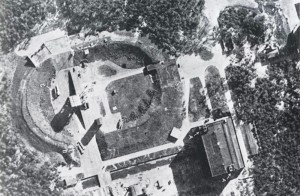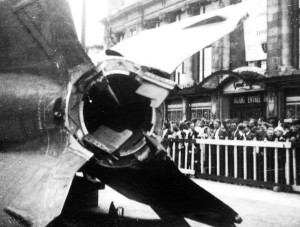Published on September 8, 2012
“I was going shopping that morning for my mother and suddenly there was a blinding flash and a roaring, rushing sound. I was thrown into the air. There was noise all around me, a deafening terrible noise that beat against my eardrums and, when I fell to the ground, I curled myself up into a ball to protect myself…. When the noise had faded I picked myself up and I was coated with brick dust, with slivers of glass in my hair. Then I walked towards Woolworth’s. Things were still falling out of the sky, there were bricks, masonry….”
Today in aviation history, on September 8, 1944, the first Vergeltungswaffe 2, also known as the V-2, struck London.

The V-2 was Nazi Germany’s second terror weapon. It was an extraordinary design, the world’s first ballistic missile and revolutionary in nearly every way. While horrific in its purpose, it was also a brilliant engineering feat. It was the first object launched into space (not Sputnik, which came 15 years later). Rather than having a goal of orbiting a satellite, instead the V-2 was designed to carry a warhead against a target. The rocket would fire for just 65 seconds, accelerating the V-2 to supersonic speeds and propelling it into space. Then, based on momentum and ballistic drop, the missile would curve over, reenter the atmosphere and descend on its target — most commonly the cities of Antwerp and London. It came so fast and was so small that it was nearly impossible to see — and absolutely impossible to intercept. Thus, the first sign of a V-2 attack was its explosive impact, a feature that only added to its reputation as a terror weapon.

Development and Design Features
The V-2’s key design features have stood the test of time. Even today, the design of the V-2 remains highly influential — though its past is marked by death and destruction, it was an amazing design. It is used worldwide in almost every rocket launched by every space-faring nation. It remains the basis for the Scud missile, of Iran’s Shahab missiles and of North Korea’s Taepodong missiles. The V-2’s innovations were many — gyros provided input to flight control systems for stability, steering and guidance. Extensive testing had defined a shape and form that could rocket upward and then descend under control at supersonic speeds without breaking up (making it the world’s first true supersonic vehicle — it is interesting to compare the fuselage shape of the X-1 “Glamorous Glennis” with a V-2 rocket). Large scale liquid fuel and rocket systems had been pioneered and proven that allowed the rocket to have sufficient thrust to lift a sizable warhead the distances required to reach London.

One brilliant innovation was applied to solve the stabilization problem of the first time period directly rocket launch, when the speed of the rocket had yet to accelerate fast enough for the rocket’s fins to stabilize the craft. Despite gyro inputs and even large swings of the rocket’s control fins at lift off, there was inadequate aerodynamic forces to keep the rocket from tilting over or even looping directly back down in the launch area. The German designers extended small, rugged and thick control tabs (sometimes called vanes or paddles) attached to the bottom of the fins that, instead of extending outward into the airstream, extended inward into the rocket’s exhaust. Thus, the very firing of the rocket provided sufficient airflow and aerodynamic forces to allow control; that same simple system that has been used extensively in rocket design ever since.

Surprisingly, Adolf Hitler, Nazi Germany’s leader, remained unimpressed. He considered the rocket engineers’ achievement to be nothing more than a highly costly long range artillery shell. It was far more cost-effective to use aircraft to bomb London. Yet this would change — with air superiority established by the British and Americans in 1942 and 1943, the Luftwaffe’s fleet of bombers could no longer attack England. Meanwhile, Allied bombing was intensifying. At home in Germany, the public was demanding ways to achieve retribution for the bombing of Germany’s cities. New ways to strike the enemy had to be achieved. Thus, the V-2 received funding and the necessary support it needed to finally become a serious tool of war.
Wartime Usage
From the first launches on this date in history in 1944 to the end of the V-2 threat, when the launch sites were finally overtaken by advancing Allied soldiers, 3,172 V-2 rockets were launched against England and areas that had been taken by the Allies. Interestingly, Belgium was hit by more V-2s than England. In all, the records show 3,172 V-2s confirmed as launched, with 1,610 V-2s hitting Antwerp and 1,358 hitting London. Approximately 230 rockets struck other cities in Europe, with the most common targets being Norwich (43), Liège (27), Lille (25), and Paris (22). In London alone, more than 2,500 people were killed and 6,000 injured during the many months of the V-2 rocket assault. In Antwerp, the numbers were as shocking — more than 1,700 dead and 4,500 injured.

In 1945, German engineers even went so far as to begin work on mounting V-2 ballistic missiles on Nazi U-Boats. The program, called Prüfstand XII, was inaugurated to allow Germany to launch V-2s against New York and Washington, DC, from offshore. In response to the threat, the US Navy instituted a program called Operation Teardrop, which deployed dozens of ships in the coastal waters and mid-Atlantic to hunt any rocket-equipped U-Boats. The Germans never launched a single Prüfstand XII U-Boat, however, though the threat was very real and clearly within Germany’s technological reach.

Final Words
Germany’s rocket scientists were primarily engineers and physicists, rather than cold Nazi ideologues. Their vision had been born in the pre-war years, yet in the midst of a war, they nonetheless worked effectively for the Nazi government. On the one hand, they had to go along with the Nazi plan or risk persecution within their own countries. On the other hand, far from innocent, they did a fine job. Nonetheless, their sights always remained higher, focused on greater goals. Tellingly, Vernher von Braun, on the news that the first rocket had successfully hit London, turned to his colleagues and announced, “The rocket worked perfectly except for landing on the wrong planet.”
Von Braun and his colleagues would have their chance. Offered freedom from prosecution as war criminals, they were welcomed into the United States, England and Russia after the war, where the former Nazi engineers formed the backbone of each country’s new space program. Years later, a Soviet scientist was asked why the Americans had beaten the Russians to the Moon — his answer was simply, “You got better Nazi scientists than we did.”
Website of Interest: Google Map of the London area annotated with V-2 rocket hits
One More Bit of Aviation History
Due to a lack of manpower, the V-2 rockets were constructed by Nazi prisoners who worked in slave labor, concentration camp conditions at Mettelwerk, with workers taken from the concentration of Mittelbau-Dora. The Nazi guards were brutal overseers and hangings, shootings and beatings were commonplace in order to ensure discipline and keep the laborers at work. Disease was rampant, health care was non-existent and food was scarce. The prisoners were literally worked to death. As a result, the V-2 has the dubious record of having killed more at its manufacturing facilities than from actual operational use, fired against London. In all, 9,000 were literally worked to death, collapsing at the job, while 350 were hanged and perhaps as many as 10,000 died from disease and starvation. An untold number were summarily shot. The workers often attempted sabotage as a final act of defiance — and records show that at least 200 were hanged for the “crime” of resisting to the end. Perhaps more than any other aspect of the V-2 development, this dark story remains the true legacy of the V-2.
Today’s Aviation Trivia Question
Before committing suicide in his bunker under Berlin in the final days of World War II, Hitler issued an order regarding the scientists who had developed Nazi Germany’s super weapons (over 200 men, including his leading scientist, Wernher von Braun) — what was the order?

He ordered them all to be killed.